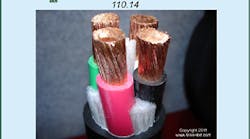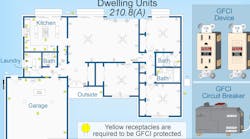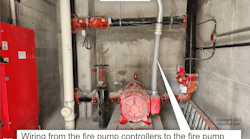Because every Article in the NEC provides requirements for electrical installations, the title of Art. 110, “Requirements for Electrical Installations,” might seem a little misleading. However, when you remember that the first four chapters of the NEC apply generally to all installations — and the last five to specific situations — it starts to make more sense. Chapter 1 has only two Articles (100 and 110). Last month, we covered Art. 100. This month, we’ll tackle Art. 110, which provides general requirements not covered by Chapters 2 (Wiring and Protection), 3 (Wiring Methods), and 4 (Equipment for General Use).
Article 110 outlines many general guidelines that govern electrical installations, one of which is the fact that you must use equipment that’s “listed” and “labeled” for the intended use, as well as follow instructions included in the listing or labeling. Some pieces of electrical equipment have special requirements (e.g., limitations on elevation, ambient temperature correction, power quality, specific types of overcurrent devices). This information may be in the product literature, in the listing and labeling information, or marked on equipment. This rule helps users know about these special conditions.
Let’s take a closer look at some of the other requirements contained in this Article, including any areas where changes have been made to the 2011 Code. (Note: The green underlined text in the accompanying illustrations represents a 2011 NEC change.)
Short circuit current rating
Electrical equipment must have a short circuit current rating (SCCR) that permits the circuit protective device to open from a short circuit or ground fault without extensive damage [110.10]. Listed equipment applied per its listing meets the requirements of this section. The SCCR of equipment is a vital part of determining whether a system or circuit can withstand the effects of a short circuit or ground fault.
As part of the 2011 revision of the NEC, “other characteristics” was replaced with specific examples in 110.10. This revision also replaces the term “grounding conductors” with “equipment grounding conductors.” The second term has a more specific meaning.
Deteriorating agents
This has nothing to do with aging characters in your favorite spy thriller series. Installers must give consideration to the presence of corrosive gases, fumes, vapors, liquids, or other substances that can have a deteriorating effect on the conductors or equipment [110.11].
You can’t use conductors in an area where there’s exposure to sunlight (ultraviolet) unless they are identified for use in such an area [310.10(D)]. Raceways, cable trays, cable bus, cable armor, boxes, cable sheathing, cabinets, elbows, couplings, fittings, supports, and support hardware must be of materials that are suitable for the environment of installation, per 300.6. Another issue is that some cleaning and lubricating compounds contain chemicals that can cause deterioration of the plastic used for insulation and structural applications.
Fine-stranded cables
Use only conductor terminal devices and splicing devices specifically identified for the conductor material [110.14], and follow the recommended installation procedures.
Fine-stranded cables and conductors are a fairly new option in the NEC (introduced in 2008, Art. 690). Usage of these cables has increased, but awareness of the special termination provisions for them has not. Consequently, the 2011 NEC stresses the need to use specific terminations for fine-stranded conductors and cables. Table 10 in Chapter 9 makes its first appearance with the 2011 revision. The new language in this section refers to that table, making its provisions enforceable by the AHJ.
As shown in Fig. 1, connectors and terminals for conductors more finely stranded than Class B and Class C (as shown in Table 10 of Chapter 9) must be identified for the conductor class (see SIDEBAR: What are Conductor Classes? below).
Fig. 1. Connectors and terminations for conductors more finely stranded than Class B and Class C stranding must be identified for the conductor class.
Per UL Standard 486 A-B, a terminal/lug/connector must be listed and marked for use with conductors stranded in other than Class B. With no marking or factory instructions to the contrary, terminals may be used only with Class B stranded conductors.
Arc flash
As part of the 2011 Code change process, the requirements for arc flash warning markings have been increased again, and the title of 110.16 has been revised. This section doesn’t provide any “protection” as the previous title (flash protection) implied. Instead, it provides for a warning against the hazards associated with an arc flash.
Electrical equipment (in other than dwelling units) must be field-marked to warn qualified persons of the danger associated with an arc flash from short circuits or ground faults. The field-marking must be clearly visible to qualified persons before they inspect or work on the equipment (Fig. 2). NFPA 70E, “Standard for Electrical Safety in the Workplace,” provides assistance in determining the severity of potential exposure, planning safe work practices, and selecting personal
protective equipment.
Fig. 2. Electrical equipment (in other than dwelling units) must be field-marked to warn qualified persons of the danger associated with an arc flash from short circuits or ground faults.
The 2008 NEC used the term “other than dwelling occupancies” in this section. Consequently, the warnings required by this section didn’t apply to multifamily dwellings, even though such dwellings might have remarkably larger services than some nondwelling occupancies. To address that issue, the Code now requires the marking on multifamily dwellings (but not the individual dwellings of a multifamily dwelling unit building).
Available fault current
A new section requires some equipment to be marked with the available fault current and requires updating of that marking if modifications of the electrical system occur [110.24].
Field Marking. Service equipment in other than dwelling units must be legibly field-marked with the maximum available fault current, including the date the fault current calculation was performed, and be of sufficient durability to withstand the environment involved (Fig. 3).
Fig. 3. Pay close attention to what the field marking must list, including the date the fault current calculation was performed, and make sure it's durable enough to withstand the environment around it.
Modifications. When modifications to the electrical installation affect the maximum available fault current at the service, the maximum available fault current must be recalculated to ensure the service equipment ratings are sufficient for the maximum available fault current at the line terminals of the equipment. The required field marking(s) in 110.24(A) must be adjusted to reflect the new level of maximum available fault current.
Exception: Field markings aren’t required for industrial installations where conditions of maintenance and supervision ensure that only qualified persons service the equipment.
All equipment must have an interrupting rating or SCCR that’s at least equal to the available fault current [110.9 and 110.10]. As wiring systems age, electric utilities may change transformers in an effort to become more efficient or to increase capacity. This can easily cause an increase in the available fault current, often with a noncompliant (and dangerous) wiring system. The intention of this new provision is that owners re-evaluate the ratings of equipment when they install on-site generation or when anyone changes the supply transformers.
Opponents of this change argue that often the ratings of equipment are based on “worst-case” scenarios. While this is suitable for designing a system, it isn’t suitable for performing the calculations required to establish the proper personal protective equipment (PPE) for working on the equipment. Using artificially high values of fault current for equipment ratings often produces a lower PPE rating.
Working space height
The 2011 NEC revises 110.26(A)(3) to include all of the height requirements found in 110.26 and adds a new exception for meters in meter sockets.
The height of the working space in front of equipment can’t be less than 6½ ft, measured from the grade, floor, platform, or the equipment height (whichever is greater), as shown in Fig. 4. You can install raceways, cables, or similar equipment above or below electrical equipment, but it can’t extend more than 6 in. into the working space of that equipment.
Fig. 4. The height of the working space in front of equipment is of the utmost importance.
Two exceptions:
The minimum headroom requirement doesn’t apply to service equipment or panelboards rated 200A or less in an existing dwelling unit.
Meters can extend beyond the other equipment.
In previous Code editions, height requirements were in 110.26(A)(3) and 110.26(E). Because there’s no reason to have two subsections giving similar provisions, 110.26(E) was deleted, and the text was incorporated into 110.26(A)(3).
Meters are obviously installed inside the working space discussed in this section. Previously, the NEC allowed meters to protrude up to 6 in. into the work space. Now meters can extend more than 6 in. into the work space.
Illumination
The illumination for indoor service equipment, switchboards, panelboards, and motor control centers must not be controlled only by automatic means [110.26(D)]. Previously, this requirement applied only to electrical rooms. But equipment addressed by this rule is often installed in spaces that aren’t “electrical rooms.” If you install panels, then provide a manual means of controlling the lighting for them.
Now that we’ve shed some light on important aspects of Art. 110, you can see why it’s beneficial to periodically read through this Article. Because Art. 110 applies to all installations, time spent understanding it pays off with every installation.
SIDEBAR: What are Conductor Classes?
- Class B stranding (Standard) features 16 strands of wire in an 18 AWG conductor, 26 strands in 16 AWG, 7 strands in sizes 14 AWG to 2 AWG, 19 strands in sizes 1 AWG to 4/0 AWG, and 37 strands in sizes 250kcmil to 500kcmil.
- Class C stranding features 19 strands of wire in sizes 14 AWG to 2 AWG, 37 strands in sizes 1 AWG to 4/0 AWG, and 61 strands in sizes 250kcmil to 500kcmil.







